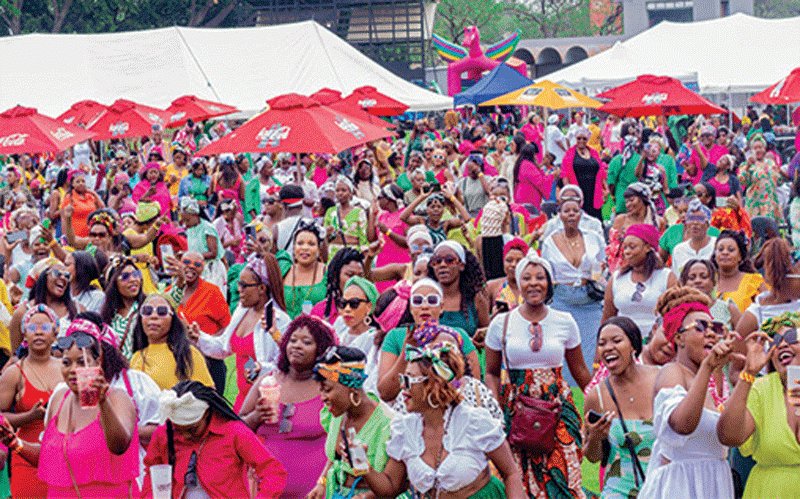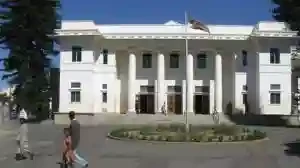
On Sunday, April 13, 2025, Harare’s Alex Sports Club was transformed into a vibrant narrative of colour and energy as women took over the streets. The atmosphere was electric, filled with laughter, camaraderie and sisterhood solidarity.
Thousands of women donned bold floral prints and elegantly wrapped doeks (headwraps).
The theme was Vintage Style — oh what a sight the women were! The air was alive with music, celebration, and a palpable sense of unity.
As I navigated through the bustling streets near Prince Edward School, it became clear that this was no ordinary day; it was the much-anticipated Doek and Slay event.
This was the third edition of Zimbabwe’s most electrifying women-only gathering, and for a few hours, Harare belonged entirely to its female attendees. In this space, there were no apologies or explanations needed, just a collective celebration of womanhood.
The sight of women dancing in unison, their spirits unrestrained, was nothing short of revolutionary. It prompted a reflection on why such gatherings evoke both joy and discomfort, particularly in a patriarchal society.
Throughout history, the act of women convening without the presence of men has frequently been interpreted as a subversion of entrenched societal norms.
In Zimbabwe, where patriarchal systems have long dictated social hierarchies, women have historically carved out spaces of resilience and solidarity.
- Dollarisation key at this juncture
- Needed: African response to Trump tariffs…by responding alone, Zimbabwe may have jumped the gun
Keep Reading
Gathering at riverbanks while washing clothes, drawing water from communal wells, or trading goods in bustling marketplaces, they transformed mundane routines into clandestine sanctuaries.
Within these spaces, generations of women exchanged survival strategies, shared ancestral wisdom, and nurtured collective strength under the radar of male oversight. These gatherings were not merely practical, they were acts of quiet resistance, preserving agency in a world that sought to marginalise their voices.
In 2025, this legacy of clandestine solidarity has evolved into a bold, unapologetic movement: Doek and Slay. Founded by visionary entrepreneur Anesu Rwanga, the initiative reimagines traditional Zimbabwean women’s gatherings for the modern era.
Rwanga, inspired by her grandmother’s stories of covert kinship at the village well, sought to create a space where women could “exist freely, without dissection or domination”.
Doek and Slay, a vibrant fusion of African fashion showcases, entrepreneurial workshops, and cultural performances, transcends mere celebration. It is a radical reclamation of space, designed to centre women’s voices, ambitions, and creativity.
Attendees don intricately tied doeks as symbols of cultural pride, while panels led by trailblasing women in technology, agriculture, and the arts dissect systemic barriers.
Pop-up markets spotlight female-owned businesses, from eco-friendly textiles to digital startups, fostering economic collaboration. Crucially, the event excludes men, not as an act of exclusion, but as a deliberate shield against the male gaze, enabling unfiltered dialogue about issues such as reproductive rights, workplace inequity, and gender-based violence.
The movement’s rapid global expansion, to Zambia, the UK, Germany, and beyond, underscores its universal resonance.
In Lusaka, workshops adapt to address local challenges, such as land ownership for rural women. In Berlin, Afro-diasporic artists use the platform to confront cultural erasure.
Yet, as Doek and Slay gains international acclaim, it also ignites backlash. Critics dismiss it as “reverse sexism”, while traditionalist groups in Zimbabwe label it a threat to cultural values. Online trolls target attendees, and male-dominated industries quietly blacklist participants.
This hostility, Rwanga argues, exposes a paradox: “The louder they protest, the more they reveal their fear of women who refuse to shrink.”
The backlash underscores a broader global tension. In an era where women’s autonomy is increasingly legislated against, from restrictive abortion laws to censorship of feminist discourse, the mere act of women claiming space strikes at the heart of patriarchal control.
Doek and Slay’s success lies not only in its economic or cultural impact but in its symbolic defiance. It revives an ancient truth: when women gather, they are not just sharing stories — they are drafting blueprints for liberation.
As the movement grows, it challenges the world to confront a simple yet unsettling question: If female solidarity is so trivial, why does it provoke such fear?
The most common critique aimed at events such as Doek and Slay revolves around accusations of exclusion. Critics often ask, “Why can’t men attend?” as if every other space in society isn’t already designed with them in mind. This irony underscores a deeper issue: patriarchy thrives on controlling women’s movements, both physically and socially.
When women carve out spaces for themselves, it disrupts established hierarchies, reminding society that women are not merely existences defined by male approval.
Moreover, the reactions on social media after each Doek and Slay event reveal a troubling truth. While some celebrate the gathering, others mock the attendees, dismissing it as “just women dancing in doeks”.
This reaction stems from a discomfort with women experiencing joy unconditionally. In a patriarchal society, women’s happiness is often contingent upon their roles as mothers, wives, or caregivers. A space where women gather solely for their own pleasure is seen as subversive. The economic implications of Doek and Slay further fuel this backlash.
The event is not just about music and fashion; it is an economic powerhouse. Female vendors, designers, and artisans dominate the stalls, fostering collaborations and mentorship opportunities. By promoting financial independence among women, Doek and Slay challenges systemic male dominance, making some men uneasy about the shifting dynamics.
The 2025 Harare edition of Doek and Slay was a masterclass in feminist resistance. The theme; vintage style, symbolised growth, vibrancy, and feminine beauty, directly countering narratives that often reduce women to mere background characters in their own lives.
What made this event truly revolutionary was its emphasis on solidarity over competition. Unlike environments where women are pitted against each other, Doek and Slay fosters collaboration and mutual support.
The event also reclaimed cultural pride, elevating the doek from a simple headscarf to a crown, representing heritage and identity.
The atmosphere was a safe haven for expression, allowing women to be bold, ambitious, and unapologetic. From the dance floor to the business expo, attendees felt empowered to showcase their true selves without fear of judgment.
As Doek and Slay continues to expand its reach, its message remains clear: Women’s spaces are not merely a trend; they are essential. These gatherings represent acts of reclamation in a world that still seeks to dictate where women belong.
To critics, the event boldly asserts: “We are not here to argue. We are here to exist, loudly, joyfully, and on our own terms!”
The women who danced in Harare on April 13, 2025, were not just attending a party; they were participating in a revolution, a powerful assertion of their right to joy, autonomy, and community.
In the words of a wise observer, until women are free, we must continue to create spaces where we can remember what freedom feels like. Until then, let us keep spreading positivity (#spreadpositivity). We were here, becoming better, making our mark, and leaving our footprint as we make the world a better place!
Chirenje writes in her capacity as a citizen of Zimbabwe. Follow her on social media for more Lifezone with Grace conversations on Twitter: @graceruvimbo; Facebook: Grace Ruvimbo Chirenje; Instagram: @graceruvimbo; WhatsApp: +263772719650.






